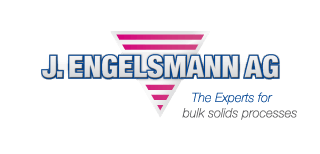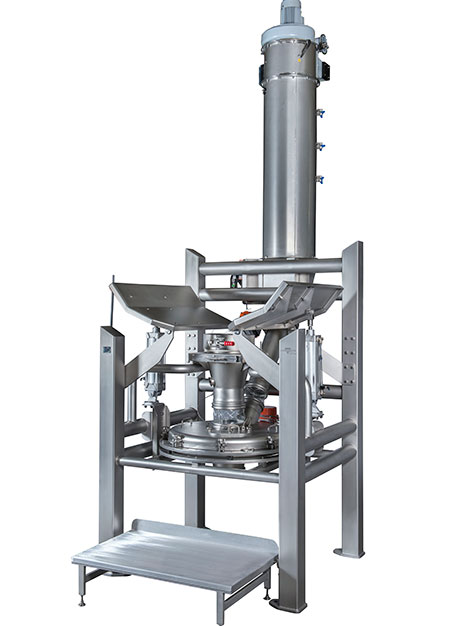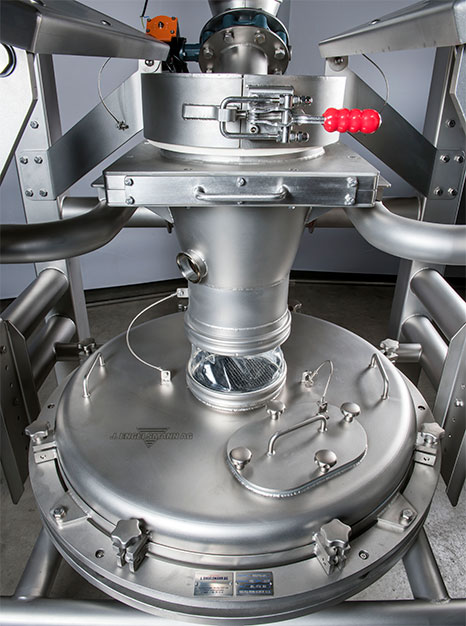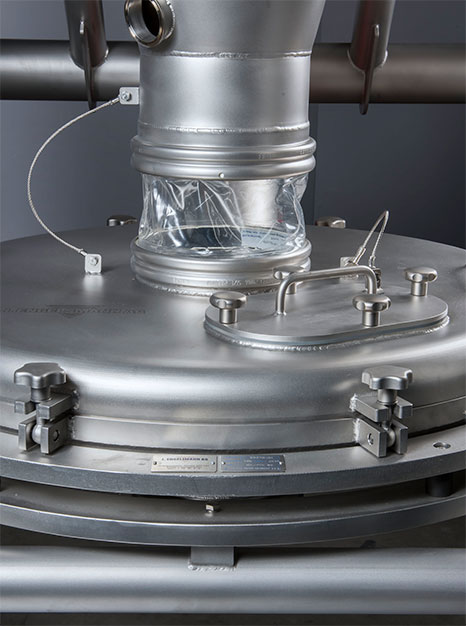- Sectors ›
- Article: Safe, dust-free and hygienic:
big bag emptying solution with integrated protective screening
15.05.2018
Safe, dust-free and hygienic:
big bag emptying solution with integrated protective screening
A screw in a yoghurt is completely out of place, that's certain. So not only in the sales product, but also a few steps earlier - namely in the production process -, a foreign body such as this can cause a lot of damage. Instead of reputational damage, there is a risk of damage to the machine, for example, if the screws are emptied along with the delivered raw materials and become wedged in a rotary feeder. Control screens that are added directly after the raw material output are a way to remedy this, as they separate off foreign bodies and impurities before they can get into the production process. But retrofitting a control screening machine means that you have to integrate an additional process step and ensure that you have the corresponding space required. However, the multi-functional emptying station with an integrated screening level from J. Engelsmann AG for manufacturers from the food sector has proven that this can be done in a different way.
Up until now, the operator used a simple solution to transport the milk powder, which was delivered in big bags, to production: the full big bag was picked up with a crane track with a load cross and deposited into a container. The operator opened the big bag outlet and the milk powder emptied itself directly into the relevant container. As milk powder generates a lot of dust when it is moved and the big bag is only connected dust-free, both the operator and the surrounding production equipment were exposed to a high dust load. This was particularly the case when the big bag had to be tied up again after emptying, as even the smallest product residue is stirred up when tying up (and particularly when folding) the big bags and can create a lot of dust at the outlet. The emptying of full milk powder presented a challenge for the operator, as the high fat content tends to make the product form bridges and without an external mechanical impact cannot empty well. However, the biggest problem was that the milk powder was fed directly into the further production process after the emptying. Possible foreign bodies were first separated off at a later point, after they had already come into contact with delicate production equipment. To avoid this problem in the future, the outdated emptying container should be switched for a modern emptying station with integrated protective screening. However, the operator didn't have the space required for that, as the old containers were narrower than the customary emptying stations and they stood close to each other in a row, directly above the conveyer device, and their position could not be changed. For an emptying station with emptying aids, as well as a protective screen and filter, the Engelsmann designers had to keep within an area of 2.5 m² - where standard solutions reach their limits.
J. Engelsmann AG developed the „PremiumLine“ product line for applications exactly like this. Like with the "BasicLine" models, the individual emptying station components can be combined with each other. These modules can also be completely individually manufactured and adjusted to the customer's needs, like in this case.
Multiple functions in a small space
The basic framework of the new emptying solution is provided by the outer frame, which is open at the top, so that the operator can continue to move the big bags with the on-site crane track. To ensure a quick and residue-free emptying, even for milk powder with a fat content, the Engelsmann designers placed their bets on the use of rockers. These emptying aids consist of two support cheeks that the full big bag rests on. With pneumatic actuation, these cheeks move upwards alternatingly and each lift one side of the big bag. In this way, any bridges are broken and the entire contents of the big bag are emptied quicker because of the improved angle of repose. Alongside their emptying aid function, the rockers also serve as a guardrail and ensure that the operator can work safely. As the operator currently uses big bags with a very short outlet, although the length may vary in the future, the rocker has been designed to be height-adjustable. With a longer outlet, the rocker can be raised by a simple modification so that the entire surface of the big bag rests on it. Even in this case, the big bag can be comfortably reached by the operator thanks to the operating platform. Due to the narrow space available on-site, the new emptying aids are also specially designed in terms of their dimensions: offset support cheeks also fit in the narrow emptying station and allow the operator to access the big bag comfortably.
For a dust-free emptying procedure, the connecting nozzle is fitted with an inflatable sleeve. After the big bag outlet is put over the sleeve and the folding covers are closed, the inflatable sleeve is activated pneumatically. The sleeve puffs itself up and firmly presses the big bag outlet against the folding cover so that any resulting dust cannot leak into the production environment.
An important requirement for the operator was that the quality of the delivered milk powder could be tested on a random basis. For this purpose, the emptying hopper beneath the connection nozzle is always equipped with a connecting piece for collecting samples. This allows the operator to take product samples from the running product flow during the emptying. The emptying unit is also fitted with emergency valves which can interrupt the product flow at any time, like if there is a tear in the screen mesh for example.
The milk powder flows through the emptying hopper and the connected BFM sleeve to the "JEL Fix" control screening machine. Thanks to its flat construction, this vibration screening machine can be installed into already existing systems. In this case, the screen insert covered a relatively large mesh width of 4mm, so that only larger foreign bodies were separated out in this first screening level. As an upright column of product may be left on the screen mesh after the emptying, the protective screen is both gas and dust-tight. A special feature of this rather simple screening solution is the simple and tool-free dismantling process, despite the fixed installation between the product emptying and discharge. Above all else, this is because of the pluggable groundings (the installation site is an ATEX protection zone) as well as the easily removable BFM sleeves which connect the control screen to the relevant emptying hopper. If this connection is severed, the screen cover can be removed from the top in a few easy steps.
Beneath the screening machine, there is the transition piece to the system's conveyer element. Whilst the milk powder is flowing through this conveyer element, a leakage nozzle draws the leaked air out of the process and guides it to the integrated filter unit. Product particles which are separated from the airflow by the bag filter elements are removed from the elements when the pneumatic filter cleaning is activated and guided away from the protective screen with the help of a pipe connection. Even tying up the big bags after emptying is significantly more comfortable for the operator thanks to the new filter unit. The big bag is evacuated whilst it is still closed. That means that the residual air, along with any possible product residue, is vacuumed up. As such, with tying up or folding, the dust build-up is reduced to a minimum.
In accordance with the high hygiene requirements of the food industry (in this case the customer was oriented towards the EU directive 1935/2004 regarding materials intended to come into contact with food, and towards the BfR [German Federal Institute for Risk Assessment] guidelines), all surfaces that may come into contact with products, such as the emptying hopper, are made from smoothed stainless steel with a surface roughness of 0.8 μm. The construction has no dead space in which product could set and rot despite thorough cleaning. Even areas which don't come into contact with the product, such as the outer frame, are adapted to the hygienic production environment: Round tube profiles, as well as the sloping roofs of the outer posts and control box housings prevent any product residue or cleaning fluids from collecting. In addition, round frame profiles are easier to clean than angular struts with flat contact surfaces.
Conclusion: Whether it be with the feeding of raw materials into the production line or with the packaging of the end products - protective screens are often the last lifeline when it comes to ensuring that there are no foreign bodies in the production process or in the end product. In particular, protective screening is an important second process step with the raw material output, e.g. after the emptying of big bags or other containers. With it, this critical section of the process "emptying, protective screening and discharging" runs as quickly and efficiently as possible and the protective screen, as this example from Engelsmann shows, can be integrated into the space-saving big bag emptying station - e.g. as an attachment directly beneath the emptying hopper. The "PremiumLine" big bag emptying solution can be individually adjusted to the space available - even the hygienic design for use with food or pharmaceutical products can be adjusted in this way.









